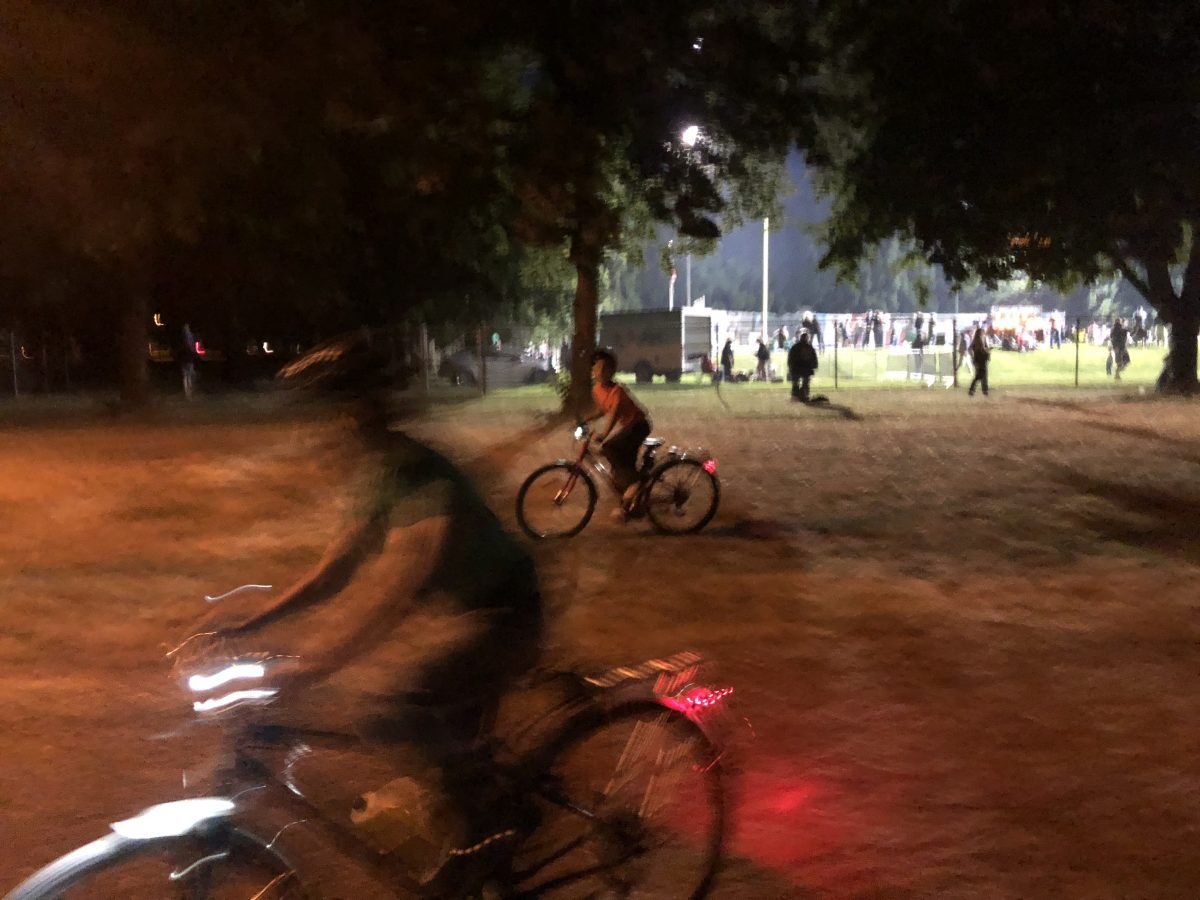
(Photos: Madi Carlson)
Kid bedtimes are getting easier now that the blazing orb of discomfort is leaving the sky well before 10 p.m.; but with that comes the need for little manufactured orbs of light. As much as it pains me to say it, the days are getting shorter and now’s the time to prepare for darker mornings and evenings.
I can tell from our packed school bike racks that there are a lot of new bike riders this year and I hope they’ll keep it up as the temperature drops and daylight hours lessen. I also bet a lot of them don’t have lights yet. If you need some help seeing the light (hardy-har), this week’s post should help you out…
➤ Legal lighting requirements
Legally, you only need a front light and a rear reflector when it’s dark out. Per ORS 815.280, “during limited visibility conditions” one must display a white light visible to the front (on your helmet is OK — it doesn’t have to be attached to your bike) from at least 500 feet away and a red reflector visible from the rear at least 600 feet when lit by car headlights.
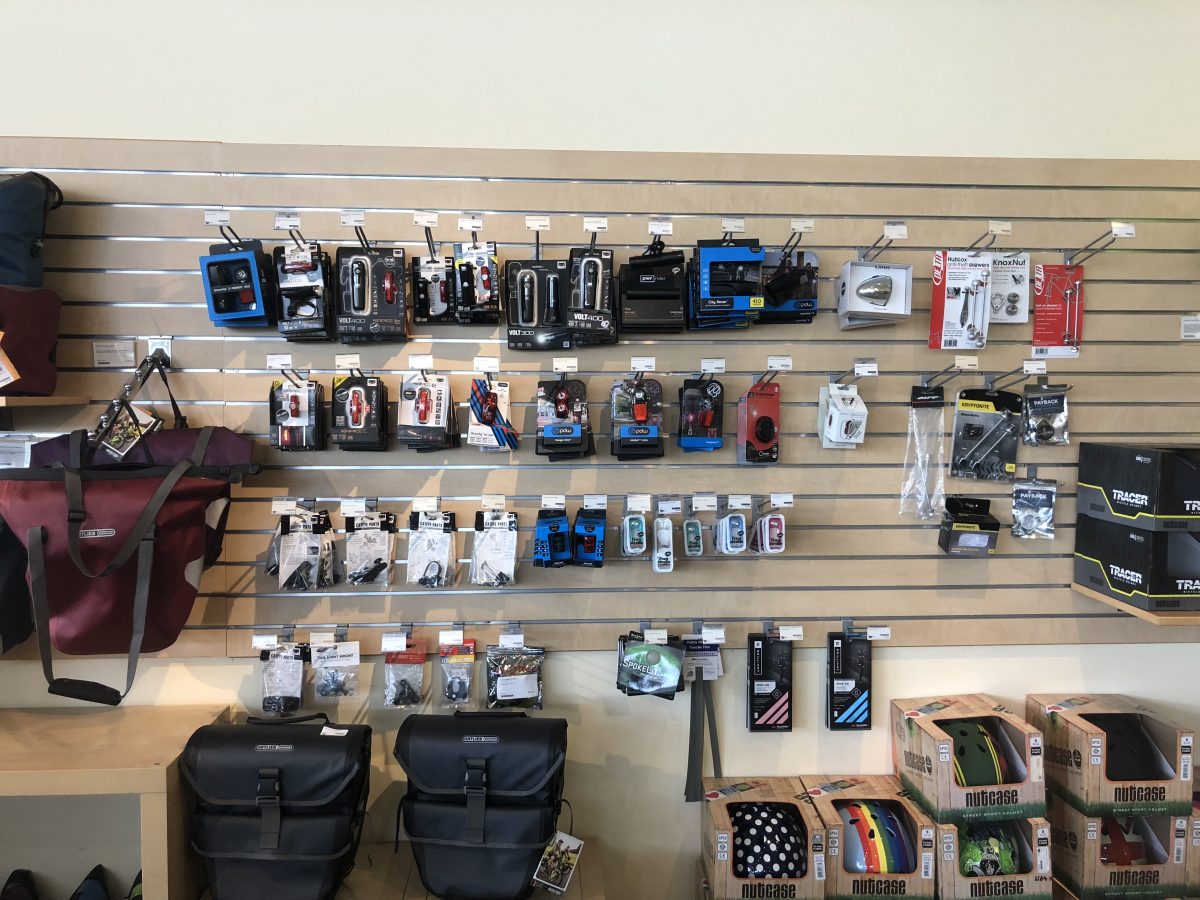
➤ Battery and rechargeable lights
Even the little free lights available at booths during Sunday Parkways and from the library during bike month (May, for kids, while supplies last) are sufficient per the 500-foot legal requirement. These lights are great for the “be seen” level of visibility. However, since Portland roads feature lots of potholes and debris, and some of our paths have tree root bumps, you’ll want something bigger than those little freebies.
I’m partial to the lights that plug in to charge so I don’t have to deal with batteries, but modern battery lights last a long time before the batteries need replacing so they’re both good options. Also, I like all our bikes to have rear lights, not just rear reflectors. Portland has a lot of people on bikes (yay) so I don’t only need to be visible to car headlights coming up behind me, but also to someone riding a bike with a freebie headlight.
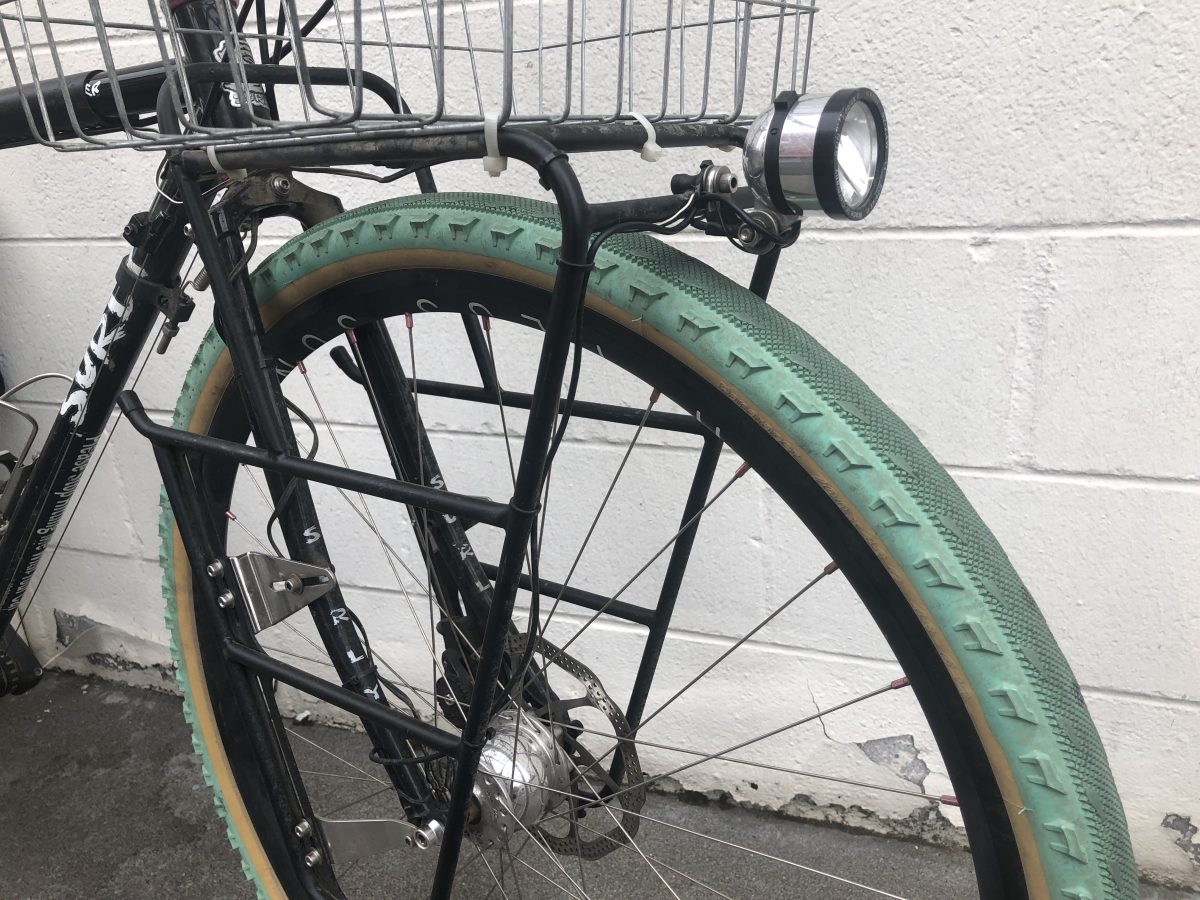
➤ Dynamo lights
I’m pretty bad at remembering to charge up my lights and put them on my bike if I’m going to be out after dark so I love having pedal-powered permanent dynamo lights. There are a few varieties of dynamos: old-school bottle-shaped ones that rub against the side of the tire, magnet-based ones, and most commonly, front hub (the part where all the spokes meet in the middle of the front wheel) dynamos. In addition to powering front and rear lights, some dynamos can also power chargers with USB ports. They’re attached to the bike making them theft-proof, forgetting-them-at-home-proof, and they’re ready to go without plugging in or worrying about batteries.
Here’s a great explanatory dynamo lighting video from BikePortland Family Biking column sponsor, Clever Cycles. And psst, no details available yet, but I hear they’ve got a dynamo special coming soon (after all, this option costs considerably more than regular lights).
Advertisement
I have dynamos on both my cargo bike and my regular bike. The front light on my cargo bike has had to withstand eight years of being bumped into bikes racks and dozens of toddlers adjusting its aim. The plastic bracket under the lens broke a couple years ago so it’s held in place with electrical tape now (I’d have to replace the entire light) and still works just fine. My front wheel was crooked for a while which messed up the inside of the hub, but that was fortunately just a small piece that needed to be replaced for not a big pricetag. My regular bike’s dynamo hasn’t had to endure any rough treatment and is good as new after four years. We don’t manage to keep our removable bike lights unbroken and unlost that long.
➤ Blink or steady?
We lived in Seattle until a year ago, where bikes cannot legally have blinking front lights (not listed with the bike laws, but buried in RCW 46.37.280: Special restrictions on lamps). This isn’t the case here in Portland, but you should still run steady front lights for the safety of epileptics and to not blind anyone with a dazzling blink.
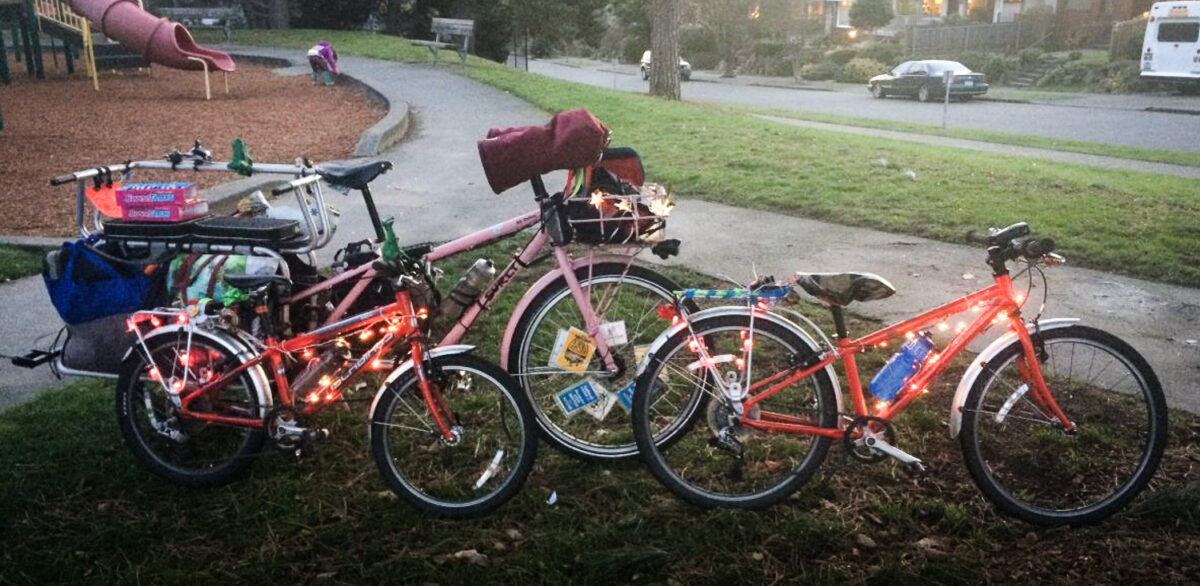
➤ Auxiliary lights
Extra lights can be fun! And they add side visibility. In the winter I add twinkle lights to all our bikes. Waterproof holiday lights are best, but even “inside use only” strings of lights from the drug store with the battery pack kept in a waterproof pouch are great and last several years.
Over the years I’ve had a couple bike-specific auxiliary lighting products, like a BikeGlow tube zip tied along my frame:
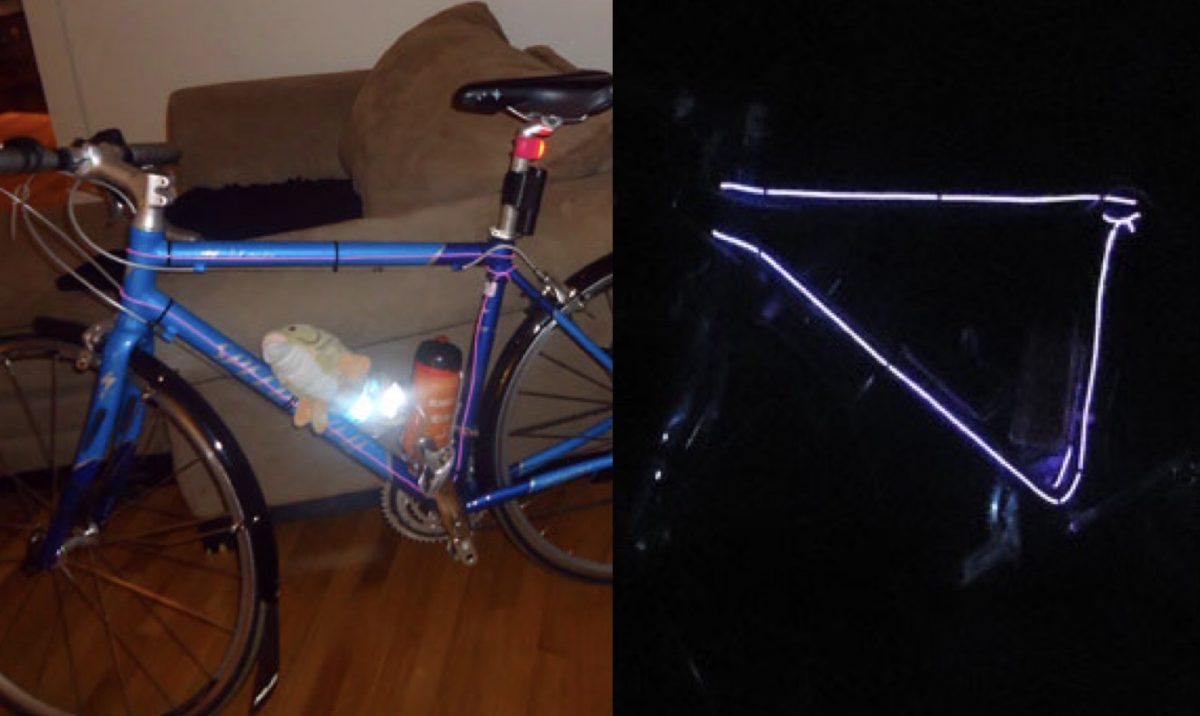
And pink “down low glow” with Go Brightz:
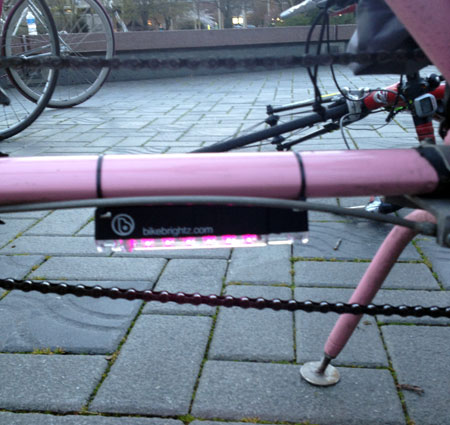
I haven’t personally used Monkey Light Bike Lights, but they’re popular for extra light. They’re also a good example of putting lights on a moving part of the bike to create even more visibility — lights or reflectors on your ankles are also good for moving lights that are hard to miss.
➤ Upcoming family night ride
Want to take your lights for a spin with a bunch of fun friends? Join Kidical Mass PDX and ride to the Chapman Swifts this week:
Friday, September 7, 6:00 p.m.
Start at: Jamison Square (810 NW 11th Ave, Portland, OR 97209)
End at: Chapman Elementary School (1445 NW 26th Ave, Portland, OR 97210)
2.4 miles, one way, our route
RSVP and join the discussion on our Facebook event page
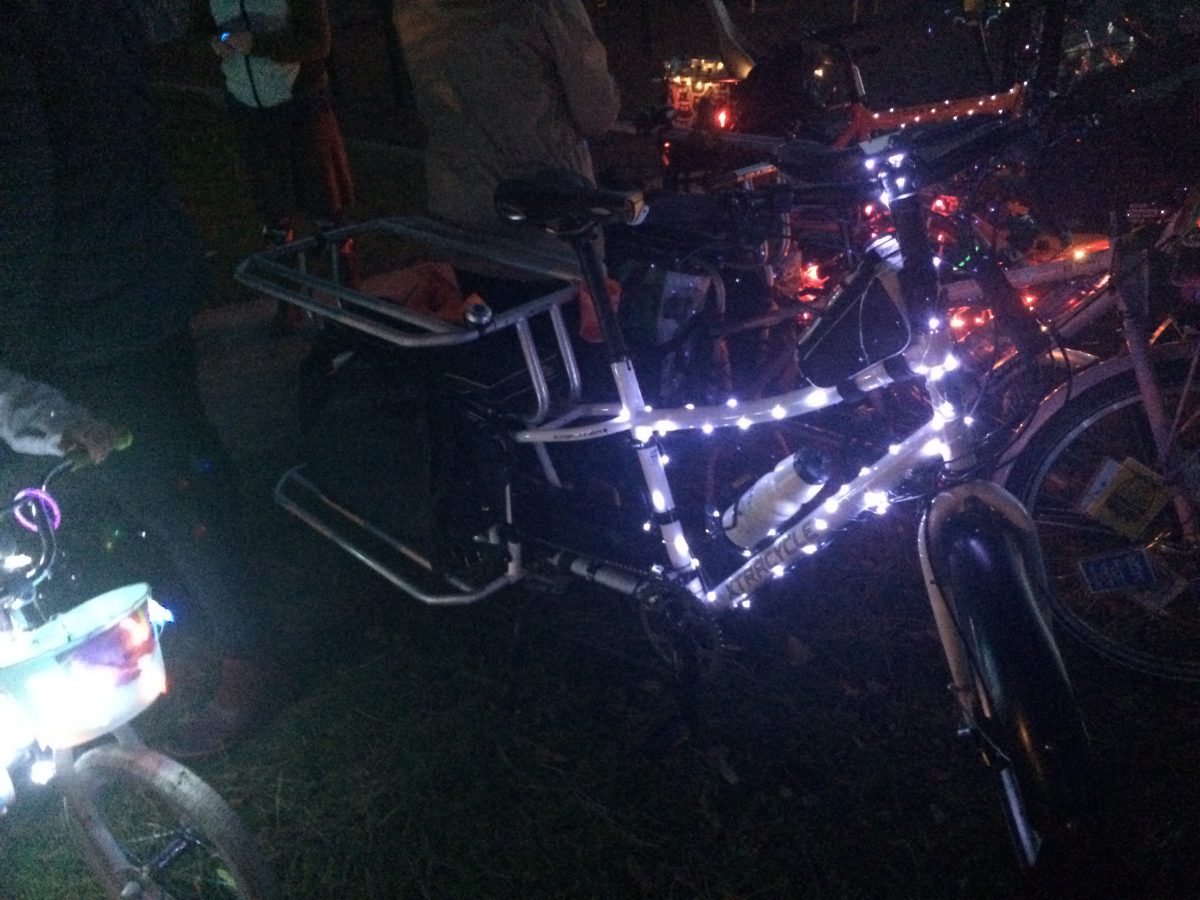
Do you ride in the dark? What are your favorite lights? Please share in the comments! Thanks for reading.
Remember, we’re always looking for people to profile. Get in touch if it sounds like fun to you. I’d especially like to feature families of color so please get in touch or ask friends of color who bike with their kids if they’re interested in sharing their stories. And as always, feel free ask questions in the comments below or email me your story ideas and insights at madidotcom [at] gmail [dot] com.
— Madi Carlson, @familyride on Instagram and Twitter
Browse past Family Biking posts here.
Get this and other BikePortland posts delivered directly to your inbox.
BikePortland needs your support.




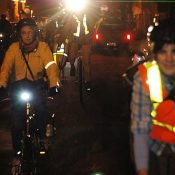


Thanks for reading.
BikePortland has served this community with independent community journalism since 2005. We rely on subscriptions from readers like you to survive. Your financial support is vital in keeping this valuable resource alive and well.
Please subscribe today to strengthen and expand our work.
I have both front and rear lights on both of my helmets (one for rainy or cold days, the other for hot humid days), so I never forget that I have one. I live in a city with poor street lighting, so I have a very bright light in front, usually a 700-1100 lumen Cygolite, with a red 50-100 lumen rear light. I carry spare lights, both front and rear, in my trunk bag, in case I’ve forgotten to recharge. Bike and accessory theft in my community is nearly nil, so very unlike Portland, so I realize your options are different.
Perhaps light thieves have a use for front lights as flash lights, but blinking rear lights are beyond useless? Keep in mind that many bike light thieves are not necessarily bicyclists themselves, nor are their customers for stolen lights.
Sorry, this was in response to John Lascurettes’ question, but the nesting feature failed to work properly.
They do. It turns out that junkies use them to look for drug stashes. I was using dollar store flashlights for headlights for awhile and they kept getting stolen.
https://www.bikelightdatabase.com
Nice post. I think the one major drawback of dynamo lights is that most (not all) stop the moment you stop rolling, making other means of visibility important at intersections, etc.
This may have been true with the 70s-era bottle dynos but no modern hub driven led dynamo light will turn off when you quit rolling.
Yep, agree with the other commenters, modern dynamo lights stay on for several minutes. So nowadays you have to factor in a bit of extra time to thank people for pointing out that your lights are still on at the bike and assure them it turns off eventually 🙂
I think pretty much zero of today’s dynamo lights turn off when you stop rolling (although the DIY ones I’ve made do that).
I am a big fan of two lights in the front and two in the rear. On the helmet and on the bike. A helmet mount in the front allows me to have light wherever I look and I am a believer in lights at two different heights to increase the odds of being seen. I am also able to direct my front helmet light at drivers that may pull out in front of me when approaching intersections. This action has saved me countless times from potential t-bone situations over the years.
Also, anyone watching your two lights moving together should be able to better gauge how far away you are supposedly.
PLEASE do not purchase lights with any type of non-rechargeable batteries.
It is absurd that non-rechargeable lights continue to be sold at all.
Remember that you can always buy rechargeable AA and AAA batteries. I use several cheap-ish AAA blinkies in various places on various bikes, all with rechargeable batteries.
I have a number of blinky lights that use replaceable batteries, and I use rechargeable NiMH batteries in all of them.
If you wan to split environmental hairs, arguably the impact of this approach (not to mention the cost) is lower than dedicated recharageable system, pretty much all of which are Lithium based.
I always rock lights on the front and back whenever it’s dark (probably a more important safety feature than a helmet, in my opinion), but if I had a single light available I’d put it on the back first, regardless of the law.
I don’t count reflectors as a valid way to be visible at night since you’re essentially competing for visibility with a hundred other inanimate objects that also have reflectors on them. Cars approaching me from behind in the dark have no ability to see me without a light, and I have very limited ability to respond to a situation where I think a car might not notice me, so I either need a light on the back or I have to plan my whole trip to avoid being overtaken by cars (ie skipping any busy roads).
I have much more control over how I interact with cars from the opposite direction – if I’m forced to limp home in a one-light situation (say, the batteries were dead on one and not the other) I only need to exercise that extreme caution whenever I’m at intersections where a car could turn left in front of me.
I also insist on using a partially-blinking front light though, so I guess I’m just an outlaw. I’ve had enough cars run stop signs in front of me without noticing while my lights were steady that I’m unwilling to risk it any more.
Re “partially blinking” front lights, at least in Washington State, that’s legal. The law distinguishes between “flashing” lights that go entirely dark and “modulated” lights that vary intensity without going dark. Flashing is illegal, modulated is legal. It’s the entirely-dark phase that causes so much trouble — glare, distraction, and triggering photosensitive neurological conditions like migraines, vertigo, or epilepsy.
I was always taught that the rear light is the most important light to have on a bike when sharing the road with cars at night. I think the logic for this is that the operator of the bicycle has greater control and decision making in forward and side movement interactions with other road users (i.e. just assume they don’t see you and avoid them), but from behind, you are mostly at the mercy of the other vehicle and so you want that red light on the rear. Plus, you had reflectors on front and sides. In other words, the rider is not simply lighting up themselves in all directions and praying that all other road users see them and respond appropriately, but rather taking an active effort in avoiding collisions. This seems like a dated attitude from a time when few bikes were on the road at night, but obviously, traditions and practices persist. And clearly not something you want to leave to your kids to figure out, although when I was a kid, we didn’t have any lights. I also think there is some throw-back behavior to the time when powerful front headlights were not easily available, and riders did not want to get lulled into staring at the small bulb of visibility only extending a few feet in front of their bike (when you are not staring at your own headlight on the pavement, you can actually have decent night vision). Now days, with the technology to blind all other approaching road users easily at the fingertips of any cyclist, you can understand how the arms race in night lighting (among all vehicles) continues to grow.
I spend a fair amount of time adjusting the angle of my bike headlight to make sure that I am visible but not blinding approaching road users. This tends to mean that the focused beam is significantly pointed down to only about 20′ in front of my bike, and the ambient light from it is plenty enough to be seen by others (unless another biker with a blazing torch pointed straight out happens to be riding next to me – then I am invisible).
Thank you for your consideration. Lights def should not be pointed straight out. Rider’s in civilized countries point them down and even shade them a bit with a hand when approaching another rider. This is especially helpful when riding trails out in the dark fringes with little or no lighting and no moonlight.
I was curious about the epileptic thing, so I went ahead and looked up photosensitive epilepsy on the epilepsy society website. Apparently one in 3000 folks or so have it, but the trigger frequency generally varies from 3-30 Hz, with a few people triggered at higher frequencies but essentially no one triggered below 3 Hz. How many bike lights flash at frequencies above 3 Hz? I honestly don’t know, but my Dinotte is slower than that as is my made in China cheapies.
I’m not convinced that the risk of triggering a seizure is great enough to warrant any sort of push-back against flashing lights. I fully agree that they are annoying and should never be used on a bike path because they make it extremely difficult to see the defects/edges on such narrow passages, especially when they are aimed right up into one’s eyes.
That said, setting lights to flashing mode has its place for me. When I’m bombing down a hill in low light conditions, I’m going to flash one or both of my front lights because it makes me stand out against all the other light sources for motorists who are considering pulling out in front of me.
Because of this issue, for the last couple of years I’ve always placed my be-seen lights in pulse mode rather than blink mode when riding at night. I still switch them to blink mode during the day, when that’s the only way they’ll be seen and the ambient light makes them less likely to trigger an episode.
I’ve been a big fan of my NiteRider MiNewt 600 that I’ve been running a few years now. Multiple brightness modes (and strobe if you want it), it’s all one piece, easily removable, and charges off a USB. I guess their newer lights are just crazy bright too. I user their Solas 150 for the rear with equally pleasing results.
tail lights are cheap so it’s common to have them mounted on the bike at all times.
I am a big fan of redundancy, since I run forward(white) and rear(red) lights all the time, day or night. My requirements are that my light(s) must be visible even if the sun shining in the observer’s eyes. To that end, I run 4 headlights and 4 tail lights, and 100 lumens is my minimum.
I have 3 of these, one on the left side of the handlebar, one on my helmet, and the other near my rear derailleur: https://preview.tinyurl.com/ydh8r67t
I have an Orfos Flare on my seatpost, but those aren’t available any longer. It’s 300 lumens at full output.
https://preview.tinyurl.com/y7732z6x
I’d recommend Cygolite’s Hotshot Pro 150 as an alternative to the Flare, which is what I’ll get if mine breaks(150 lumens). https://cygolite.com/product/hotshot-pro-150-usb/
I have 2 Anker Bolder LC40s, each powered by Panasonic NCR18650B batteries, one on the helmet, and the other below the handlebar. They may be powered by 3 AAAs @ 250 lumens, or a single 18650 @ 400 lumens. https://preview.tinyurl.com/y7z8m6lp
My primary headlights are 2 of these, and I highly recommend the wide angle lens. I only run them at medium power, which is plenty bright.
https://preview.tinyurl.com/yd3vef6p
Wide angle lens: https://preview.tinyurl.com/y7nqfqy9
“I’m partial to the lights that plug in to charge so I don’t have to deal with batteries,”
You are still dealing with batteries, just that you can’t swap them out on most lights with a built in charger. I much prefer to swap out the batteries as needed, I never want a light that I can’t do that with. Imagine that one day you forgot to charge your light or you had a longer ride that your light died… than what? Stop into a coffee shop and sit for an hour for your light to charge? Or bring a battery bank to hook it up too? At that point, you know that just being able to swap batteries would be a no brain option.
Good article, Maddie! And an extra thumbs-up for endorsing solid beam headlights!
Those bright flashing lights are terrible. The ones mounted on helmets are even worse….since they’re at “eye level” for fellow cyclists.
Others must agree because this is our most liked Instagram post, two years running.
While it specifically addresses the use of these blinding lights on bike paths, we’ve come to dread them everywhere.
https://www.instagram.com/p/BZq0mkZgigs/?taken-by=rivelo_pdx
When I’m driving, I feel like I notice flashing lights faster (emergency vehicles must have the same thought, as their emergency lights flash). I could be wrong and maybe only using selective memory.
When I was still living in the States, I would also set my front battery-powered light to blinking mode in the hopes that it would be more visible to motorists. Since I was usually the only person biking around in Tallahassee, it probably wasn’t an issue. Here in the Netherlands it is not legally allowed to have blinking lights in the front or back. But it’s probably because so many people bike here that, especially in the city centers and on busy arterial roads, I imagine it would be an absolute nightmare for everyone to be seeing hundreds upon hundreds of blinking lights everywhere!
Helmet mount and handlebar mount headlight. Flashing handlebar light when overcast/rainy, but not after dark. Flashing rear light unless sunny.
I mostly agree, but a pulsing/flashing rear “be-seen” light also helps in sunny conditions when you are heading into low-angle sun, or when you are riding in and out of shadows like along a tree-lined road.
hypothesis: you can see what is in front of you and react accordingly. The light in the back is for overtaking vehicles that are much harder to track and avoid.
Has anyone seen any news regarding the outcome of Tamar Monhait’s family’s suit against the garbage truck company? Last I heard the company was arguing to reduce the amount of the liability based on the fact that she did not have a legally-required front light.
https://portlandtribune.com/pt/9-news/376711-260524-portland-garbage-company-claims-cyclist-caused-her-own-death
Since a jury will ultimately weigh the facts and determine the liability amount, it’s worth a look at the comments at the bottom of the story, and imagine similar deliberations.
There are two issues here, seeing and being seen.
I have not used high-end lighting systems, and no cheaper one ever has enabled me to ascertain condition of the street ahead of me, although they readily pick out reflective license plates 300 feet beyond. Riding at night on familiar streets one ought to know where nasty bumps and holes are a priori in order to be safe.
No question that even cheap lamps enable one to easily be seen, from front, rear, sides. And the development of LEDs has enabled occasional night-riders to get substantial life from ordinary batteries. We now take this for granted, but lighting up was problematic not so long ago.
Robert Hurst’s dictum of “absolute responsibility” for cyclists is important in this context. I confess to “going ninja” once in a while on familiar streets–never on a busy arterial–just to keep all my senses sharp. At night I perceive cars on cross streets when they are much more distant because their headlights are so powerful. Cars approaching from behind illuminate the down tube.
And sound! Sounds of engines and tires scream “DANGER” whether in front, behind, to the side. I’d like to think I can differentiate unseen approaching cars from overtaking ones by Doppler effect–but that’s pushing it.
I do not recommend ninja mode for all but the most perverse. For one thing, it takes a while for eyes to “dark adapt.” Maybe 20 minutes before the rods fully take over from the cones. Even in the bright our rods provide peripheral and motion vision; at night they take over completely.
At night we perceive the world in different, peculiar, interesting ways. It is worth exploring the world of darkness!
Haven’t done it for years, but I used to go ride in Forest Park as it was approaching dark and delayed turning on my light as long as possible. Many times I made it all the way to Germantown Rd before hitting the lights. It is amazing how well your eyes adjust if they’re not getting hit with lights.
Huge fan of a helmet light in addition to a handlebar light in the depth of winter. Can’t tell you how many times I’ve had a driver about to pull out in front of me and I just aim the light right at them and it’s like I reached out and tapped them on the shoulder and they suddenly see me.
In winter I use a very modest helmet light, probably well under 10 lumens. Aimed properly it is still enough to wake up an inattentive driver (without blinding them), and is also handy for reading my bike computer in the dark, which I can’t really do without a helmet light.
You’re right that almost all of the danger is in front of you rather than behind you, but that’s not how most people feel. Many people are more worried about getting hit from behind, hence a rear light even though the front is more important.
The brightness you need for a see-where-you’re-going light varies immensely depending on conditions. Your mileage may vary:
– I have a 100-lumen light on the bike I keep in Portland, and it’s enough for most situations I find myself in. There are times I’d want a bit more, but it mostly does the job.
– But when I used to commute over the west hills, bombing down steep hills into Portland at 25mph+ on roads shared with cars, with poorly lit pavement and lots of ambient glare from car headlights, sometimes in pouring rain and wearing glasses to keep the rain out of my eyes, I found 500 lumens to be an absolute minimum at times.
– Here in Minnesota, during headlight season rain and wet pavement are rare: usually, either the pavement is dry, and/or there’s snow on the ground, which creates a huge amount of ambient light; plus I don’t have to deal with the West Hills. My commuter light is a Busch&Muller unit that probably emits well under 100 lumens, and it is usually enough.
Also, as others may point out, lumens aren’t always an accurate measure of how well a product lights up the road. The above figures assume a reasonably tight beam; if your light has a broader beam like those horrible MagicShines that flooded the market a few years ago, most of the light may be going off to the sides, up in the trees and into fellow cyclists’ retinas more than the road in front of you. A well-designed 200 lumen light will illuminate the road better than a flood beam with 1000 lumens. Please make sure to buy a light with a reasonably narrow beam, and aim it properly!
Hey Madi — thanks for an informative article.
As someone who has lived with increasing night-blindness since high school, I’m at the point now where I seldom ride my bike at night anymore outside my local neighborhood — and NEVER when it’s raining (because with poor night vision, all the lines in the road disappear and the car headlights can blind me for up to five full minutes).
Because of my infrequency of night riding, a generator system doesn’t really make financial sense for me. So I like the basic headlights from PDW and Planet bike, with rechargeable batteries.
Here’s a couple photos of light attachments on my regular bike, including protective mounting for the headlight (under the basket) and a homemade “bash guard” for the rear:
https://www.flickr.com/photos/bethness/28097238492/
https://www.flickr.com/photos/bethness/5593507733/
BTW, what are those green tires in the header photo, and what size are they? Thanks again and happy riding!
Thanks for the photos! Both your lights look so well mounted. The green tires are Simworks THE HOMAGEs and they only come in 43mm. Mine are the 700c ones, but they also make a 650b version. It’s just about time for me to go back to my slick 38mm tires so I can fit my fenders back on, but it’s been fun having these conversation starters on all summer 🙂
I recommend a head light on the bike and another on the helmet. Both lights should be aimed down so it normally points at the road, not into the eyes of drivers or cyclists. To point the helmet light at a car (one that is about to turn in front of you) you just tilt your head up a bit. Both should be solid, although switchable to pulsing when really needed.
For tail lights, I recommend one on the bike and one on the backpack or helmet. I prefer pulsing or flashing tail lights.
Finally, you can wrap a cheapo blinky around your hub for a very attention grabbing effect.
I think most of the observations are correct: people think the risk is from behind, though it is not, mostly because cars come up from behind so much slower than from in front. Imagine a biker at 10mph and a car at 25mph. The difference between bike and car is 35mph head on, but only 15mph from behind. If you get hit by a car at 35mph, it is a high risk of death or injury, while if you get hit by a car at 15mph, there is a low risk of death or injury.
Also rear lights are cheaper.
Another reason is that rear lights last so much longer! A rear light with a single AA on blink mode might last dozens or hundreds of hours. So that front light you aren’t seeing might be there, but not working!
In Dynamo-land, fat and happy,
Dween
Been riding at night regularly since 1973-74. I’ve evolved to using a single generator powered (hub these days) headlight and multiple taillights, on helmet, seat stay, and fender. Blinking headlights are not that useful–they won’t show you the board in the road that will take you off your bike and result in your broken arm. Easy on/off battery headlights have a major mechanical problem in that it’s harder to set them up in exactly the right position every time you use them–I’m sure most of them can be improvised with more permanent mounting. USB lights seem like the big advance if you don’t want to ride with dynamo drag, and the hours per charge can be longer than the hours per battery change. I won’t go into the simpering enviro piety of kvetching and moaning about throwing batteries away–it’s just an expensive way to ride. Headlights with replaceable batteries only start out cheap. Seriously, if you don’t want to put some real lights on your bike please just stay home at night!
Claims that lights markedly improve cycling safety in well-lit urban areas are mostly anecdotal. It would be a good idea to actually test these claims some day.
I love having dynamo lights. It took a lot of research to find out what to get and set up but worth it. I don’t have to ever think about it anymore. I even run them in the daytime since it costs me nothing. They also don’t seem to be of interest to thieves.
The best lights are from Europe (of course.)
Trelock makes some good ones. You might have to fly to Europe to get one though.
https://www.trelock.de/web/de/licht/dynamo/dynamo-frontscheinwerfer.php
A good back light is the Spanninga Elips. They’re sold in this continent.
https://www.fourthfloordistribution.com/collections/spanninga/products/elips-xds-rear-carrier-50mm
There are others.
Now a dynamo hub is hard to find at a good price. I find most stores only stock high end brands. Shimano makes more affordable ones but they don’t seem to distribute them to North America.
Several Portland LBS carry Shimano dyno hubs, and they are in many online catalogs for USA; probably Canada, too. Thanks for the light suggestions!
What a lot of comments. Maybe bike lights are as click-baity as helmets.
Side visibility is an issue in my city because of the number of people who think that stop signs and traffic signals are merely suggestions. In an effort to get these drivers to look up from their phones, I fastened a pair of rechargeable LED road flares to Velcro water bottle brackets. I fasten the red one to my seat post as a tail light, and fasten the yellow one horizontally on the underside of the top tube where it meets the head tube as a side visibility light. The Velcro water bottle bracket mounts also let me take the lights with me to avoid ‘feeding the thieves’.
I’m aware that there are commercial side visibility lights, but the ones that I found had sealed batteries that could not be replaced, which meant that I would have had to replace the light just because of a bad battery. These LED road flares use RCR123 batteries that can be replaced when they fail using a screwdriver.
WOW! I have never seen those before. Do you mean these magnet lights: Rechargeable LED Road Flares?